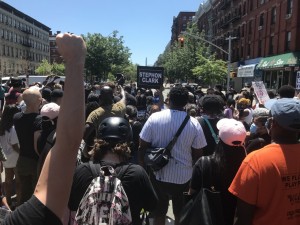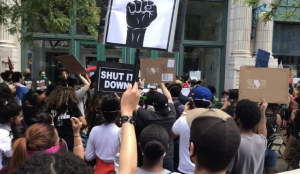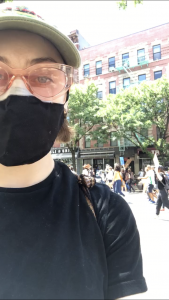
A march in Harlem, NYC, in mid-June, 2020. (This photo and others courtesy of Hallie Chametzky.)
There was dancing in the streets. There was dance amidst the protests which swept the country and the world, spurred by the murder of George Floyd at the hands of the Minneapolis Police Department, and in response to centuries of white institutional, systemic violence against Black people. Every time I took to the streets during this sweltering summer, I witnessed people dancing, and my experience is not unique.
In front of the Philadelphia City Hall, hundreds of protestors did the Cupid Shuffle just feet from a tense verbal confrontation between their fellow protestors and police. In Detroit, the linear motion of marching feet blurred with the linear motion of the dabke, a Levantine folk dance. Black Visions Collective, a Minnesota-based organization committed to Black liberation and a leader in transformative justice in George Floyd’s home state, tweeted about a “Black Joy Dance Party in front of the police federation.” MiRi Park, scholar and choreographer, created an awe-inspiring resource which lists each documented instance of dance in the protests by day. At the time of my writing this, there are almost 200 entries. From voguing in the faces of stoic police officers in Los Angeles, to activists from the American Indian Movement dancing around the felled statue of Christopher Columbus which they pulled down at the Minnesota State Capital, to a cypher in Philadelphia featuring some very young, very skilled movers, the links in Park’s list are well worth your clicks.
These stories tempt a lot of us white folks to wax poetic about the power of dance to unite and uplift. This mindset minimizes the complexities and nuances of dance as a radical expression of resistance. Black dance in protest isn’t all about joy. As Amya Mugler noted in a recent New York Times article about the radical uses of dance, “Dance is not a celebration; it’s an expression.” Furthermore, it is irresponsible and narrow-sighted to ignore another aspect of the way dance is being used—and abused—in this moment.

A march in Washington Heights, NYC, in late May, 2020. Photo courtesy of Hallie Chametzky.
Critical to this conversation is clarity that the history of Black dance in the United States is a history of resistance, revolution, and survival. Much of the history of white dance in this country is mixed up with the history of violence, theft, and colonization.
One thinks of the racist, exploitative 19th century minstrel shows which allowed white performers to profit from mimicking and appropriating black people’s song and dance. Or, in the 20th century, how white choreographers such as George Balanchine co-opted the brilliance of Black choreographers such as Katherine Dunham, with the resulting work being lauded as innovative, radical, white creativity.[1] This back story of dance in America is left out of white dance lovers’ fantasy that their preferred art is, by its very nature, unifying, and that anyone who enters the dance is engaging in a humane, liberatory practice. While dance’s potential to lift up a movement can’t be overstated, it also cannot be assumed.
During this most recent wave of protests, white people could be seen sharing “heartwarming” videos of police, and even the military, dancing at protests. At a time when many white people are nervous about what they perceive as a new level of division and chaos in the country, these videos serve as calmatives. They assure white viewers that many cops are good guys–officers of the peace, whose dance steps remove them from those men in blue who looked on passively as Derek Chauvin snuffed out George Floyd’s life. The videos counter the perception that police are an aggressive, militaristic force enacting violence on the very people they are sworn to protect. But you can’t slip institutional issues with individual examples. A 30-second viral video of an officer dancing does not erase history of the police as slave patrols, as the enforcers of Jim Crow laws, as the sixth highest killer of Black men in America today.
Not to mention, many of the social dances these officers are joining in on are Black social dances. The very group of people enacting violence on Black communities then benefiting from those communities’ dances creates a new, insidious form of 21st century minstrelsy.

The author at a march in Harlem in mid-June, 2020.
At the moment white people on Twitter and Facebook were busy applauding police officers for getting down with protestors, a New Yorker tweeted about cops charging, tackling, and arresting protestors who’d been having a dance party to Tupac. In late May, Mali Watkins was shoved around, pinned to the ground, and arrested (TW for police violence in link) while neighbors and friends watched and pleaded with the officers to let him go. His crime? “Dancing in the street,” which he is known for in his community because he does it every day.
Yes, dance is powerful. Yes, dance has been deployed as resistance, as prayer, as sanctuary, as organizing. No, it will not magically unite us. Dance will not heal racial wounds or prove there are good cops who will overcome the system from the inside. Dance might save us, but not if we continue to allow white supremacy, capitalism, and patriarchy into our dance.[2]
Notes
1 For scholarship on this history, Brenda Dixon Gottschild’s Digging the Africanist Presence in American Performance: Dance and Other Contexts is a seminal text and a great place to start.
2 Read Nana Chinara’s “An Open Letter to Arts Organizations Rampant with White Supremacy”
Adapted from an essay originally posted in Contact Quarterly: a Dance and Improvisation Journal.